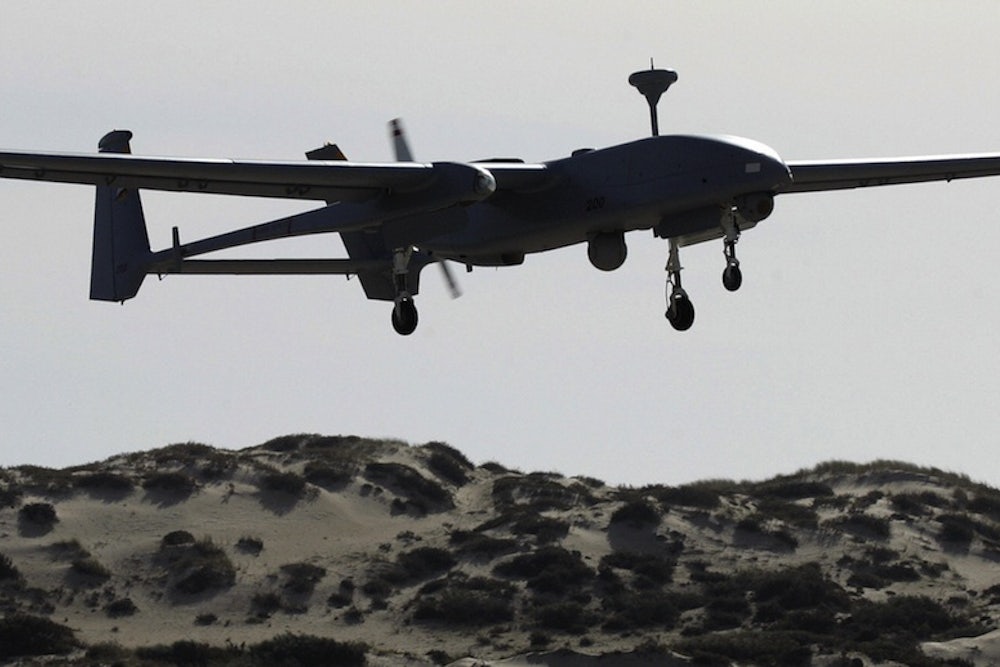This morning the New York Times reported that Israel had intercepted a drone near the city of Ashdod following a week of air and missile strikes. The drone, the Times wrote, was not a one-off:
The military wing of Hamas claimed responsibility for sending a “number of drones” into Israel, describing the event on its website as one of the “surprises” it had promised over the last week and saying the drones had been dispatched on “special missions.” An Israeli military spokesman did not rule out that the possibility that the Palestinians had access to additional drones.
Drone warfare in the region is nothing new, as Yochi Dreazen reported for The New Republic this past March. "Over the past 18 months, drones piloted by Hezbollah—but almost certainly built and supplied by its patron, Iran—have penetrated Israeli airspace, coming unnervingly close to key infrastructure sites and major population centers." What is new, and what Dreazen predicted in his story, is that Hezbollah's drones "soon may be joined by others sent be Hamas."

Why escalate to the point of sending drones into Israeli air space? First, since Israel "boasts one of the most extensive, sophisticated, and deadly drone fleets in the world," as Dreazen says, it's a bit of psychological tit for tat:
Hezbollah’s drones represent the next evolution of warfare-by-remote-control, when weaponized robotic planes give terrorist groups de facto air forces. As Matthew Levitt, director of the Washington Institute’s Stein Program on Counterterrorism and Intelligence, points out, each flight into Israel is at minimum a significant propaganda victory for the militia. “They gain more credibility anytime they compete with the mighty Israeli air force,” he says. “They love being able to say, ‘Israel is infiltrating our airspace, so we’ll infiltrate theirs, drone for drone.’ ”
Secondly, drones have the capability to be much more deadly than surface to air missiles. "Drones flown kamikaze style could easily match the casualties of a suicide bombing and be much harder to stop," writes Dreazen. What's more, they provide a way for groups like Hezbollah and Hamas to record surveillance footage and then more consistently hit targets.
So what does the future of drone warfare hold? Dreazen outlines who posseses what capabilties, what protocols are already in place, and how Israel is responding to their neighbors' technological advances. And he provides one truly terrifying anecdote:
On October 6, 2012, the Israeli military began tracking an unmanned aircraft as it flew south from Lebanon and out over the Mediterranean Sea. The drone banked to the east, swooped over the Gaza Strip, and crossed into Israel. Its flight path showed that the craft was headed in the direction of the Dimona nuclear facility, one of the most protected sites in the whole country.
The drone flew on, zooming over the Yatir Forest, a rolling expanse of pine trees, eucalyptus, and acacia. A pair of F-16s from Ramat David closed in. The pilot of one of the jets fixed the drone in his sights, sending it to the ground in a rain of fiery debris—but not before the device had managed to penetrate roughly 140 miles into Israel, deeper than any enemy aircraft in decades. Dimona lay just 20 miles away. The drone could have transmitted back pictures of the plant’s layout and defenses. Had it actually struck the nuclear facility, the impact would not have done enough damage to trigger a nuclear meltdown, but the incident would certainly have caused a mass freak out.
